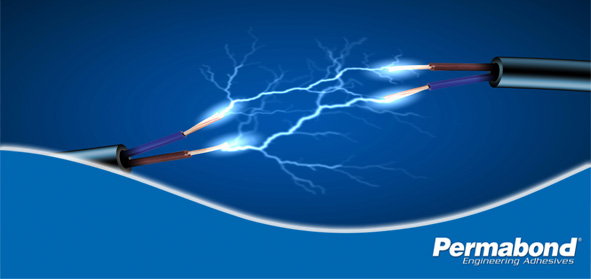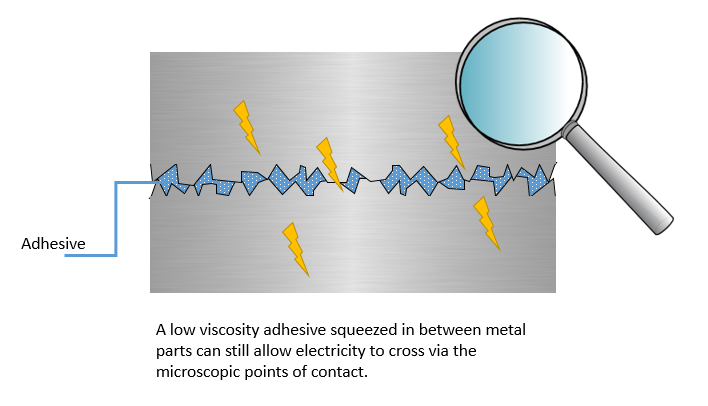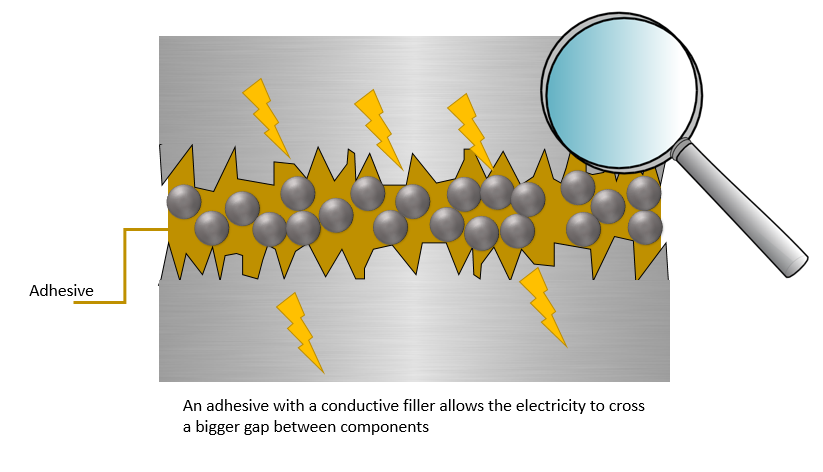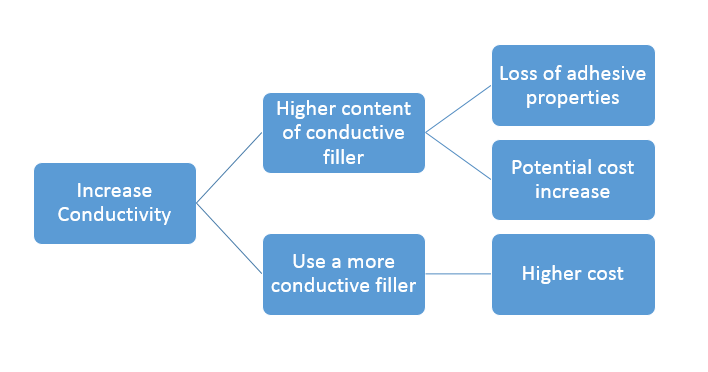Is Hard As Nails Conductive

Electrically Conductive Adhesives
Electrically conductive adhesive products are primarily used for electronics applications where components demand to be held in place and electrical current tin can be passed between them.
Depending on gap between components, well-nigh full general adhesives (such equally anaerobics, cyanoacrylates, epoxies, and acrylic-based adhesives) act as an electrical insulator. Some offer improved thermal conductivity to help with thermal direction of electronic components and oestrus sinks, directing heat away from sensitive components. Because in many cases (specially when using an anaerobic or cyanoacrylate agglutinative) at that place is no glue line control and effectively parts are touching (with adhesives filling in microscopic crevices), some electrical charge can still be transferred as there is enough metal to metal contact still occurring.

Certain temperature-sensitive electronic components cannot be soldered (as the intense estrus of liquid solder and the soldering iron can cause damage to the component). This type of awarding calls for an electrically conductive agglutinative that can be used in place of solder. PCBs with components attached to both sides can besides benefit from using an electrically conductive adhesive equally assembly process is easier without take chances of components dropping off the underside when parts are soldered on the top. Using electrically conductive agglutinative for an entire electrical assembly negates the requirement to undergo a solder re-flow procedure.
Applications for electrically conductive adhesives aren't but limited to bonding components onto PCBs or dice adhere, they tin be very useful for other electronic applications where substrates are temperature sensitive – such equally for touch-panels, LCD displays, coating and bonding RFID chips, and mounting LEDs. Solar cells also use adhesives instead of solder as there is less warpage and damage to the sensitive wafers that make up solar cells.
Selecting an Electrically Conductive Agglutinative
There are some vital points to consider when selecting an electrically conductive adhesive:
- Level of electrical conductivity (or volume resistivity).
- Viscosity and rheology of the adhesive – does information technology need to menstruum well or stand as a proud drop (with high "wet" force).
- Filler particle size – what is acceptable or necessary?
- Curing mechanism and cure speed – how do y'all programme to cure the agglutinative due east.g. two component mix then room temperature cure, or heat cure – if the application involves temperature sensitive components, is a heat cure suitable? How quickly does the adhesive demand to cure?
- Production line considerations – how fast is the throughput? Is the process fully automated or manual? How will the agglutinative be dispensed?
- Nature of the materials existence bonded and level of adhesion required – joint blueprint, strength required, whatever differential thermal expansion and contraction, Thermal conductivity, glass transition temperature, flexibility requirements.
- Environmental service conditions – temperature, exposure to chemicals, humidity, etc.
- Tests that the adhesive must pass eastward.g. drop tests, accelerated aging tests.
- Colour, odor, health and safety considerations, aircraft, storage, and shelf life.
- And non forgetting 1 of the nigh important considerations – toll!
Types of Electrically Conductive Adhesive
Electrically conductive agglutinative tin exist based on several unlike chemistries:
- Electrically conductive silicone adhesive – these can be graphite filled and are often used for EMI/RFI shielding or for antistatic systems. These materials are mostly a very high viscosity, thick consistency making them suited to larger applications such equally gasketing or bonding / sealing large areas. The conductivity is fairly express (then they are not a good replacement for solder). Volume resistivity is typically virtually 0.09 Ohms∙cm.
- Ii-component epoxy adhesive – these incorporate resin and hardener and are available in a range of viscosities (if heavily filled with conductive metal, viscosity can become quite high). If filled with silver, book resistivity can exist as low as 0.0001 Ohms∙cm.
- One component epoxy adhesive – these are normally heat cured and then care must exist taken to choose a cure schedule which won't compromise sensitive electronic components. Snap-cure frozen epoxies are also popular for the electronics manufacture; these products crave freezer storage and cure once they reach room temperature. These can be expensive to transport and store. A silver filled ane-part epoxy can achieve electrical conductivity as high as a similarly filled two-part epoxy.
- Argent-filled polyurethane adhesives – these are starting to appear on the market. They are two-part adhesives, so they either require mixing or they are supplied pre-mixed and frozen like the snap-cure epoxies. They offer high peel strength and flexibility. As they are silver filled, high levels of conductivity can exist achieved (around 0.0001 Ohms∙cm to 0.0004 Ohms∙cm).
Developing an Electrically Conductive Agglutinative
Every bit with many things in life, there are certain trade-offs. In the case of electrically conductive adhesive they are:

Conductive fillers tin be considered as follows:
| Material | Conductivity (1/(Ωm)) | Cost | Comment |
| Ag (Silver) | 6.29 x tenseven | Very high | Best textile but very expensive. |
| Cu (Copper) | five.95 ten ten7 | High | Beware of impurities and material strength. |
| Al (Aluminium) | 3.77 ten 107 | Medium | Limited electrical conductivity. |
| Iron (Iron) | i.03 x xseven | Low | Adhesive becomes very thick, heavy, and difficult to dispense. Very |
Electrical Properties of Adhesives – Terminology
What are conductivity, resistivity, and dielectric strength, how are they tested, and what do the measurements hateful? Looking at technical datasheets comparison products tin be very confusing. So many different units of measurement are used and it is very difficult to compare competitor products when nobody is using the same exam methods or UOM. For this reason, it is ever a good idea to test the adhesives to bank check suitability rather than condemn an adhesive based on comparison technical datasheets.
Dielectric Strength
This pertains to electrically insulating adhesive i.e. the electricity must not be conducted. Many potting and encapsulation applications require an epoxy mucilage with high dielectric strength.
This is the maximum voltage the adhesive can withstand earlier it is destroyed – information technology is also known as "breakdown voltage" for reasons which explain themselves.
The standard manufacture exam is ASTM D-149. Results are afflicted by adhesive thickness and the temperature at which the testing is done. It is important to compare similar-for-like!
In the US, dielectric force is often specified equally volts per mil (a thousandth of an inch). Elsewhere, it is mainly 5/cm (or mm or m)
To catechumen:
i V/chiliad = 2.54 x x-5 Five/mil
1 V/mil = 3.94 x 10iv V/thou
1 5/m = 0.001 V/mm
ane V/mm = m Five/m
ane 5/mm = 1 kV/m
1 kV/mm = 1000 kV/m
As a comparison, typical dielectric strengths of different adhesive types are:
| Anaerobic | 11 kV/mm |
| Cyanoacrylate | 25 kV/mm |
| Structural Acrylic | xxx-50 kV/mm |
| Heat Cure Epoxy | Between 17 and 45 kV/mm |
| 2-Role Epoxy | 15 to 25 kV/mm |
| UV Curable Agglutinative | 12-thirty kV/mm |
Dielectric Constant
This is the ability of the adhesive to store a charge (electric flux). This is afflicted past temperature and too glass transition temperature (Tg) of the adhesive every bit insulating properties alter above and below the Tg. The higher the Tg, the meliorate the retention of dielectric properties at elevated temperatures. Typical values for insulating epoxy glues are around 4 to six at around ane mHz.
Volume Resistivity
This measures the conductivity or electrical resistance of materials, taking into account sample dimensions (hence the "book" part). Test standards associated with this are the old MIL STD-883, ASTM D2739, and ASTM D257-99 which is a test method for measuring DC resistance or conductance of insulating materials. Units of measurement associated with Book resistivity are typically Ohm∙cm.. The lower the figure, the more electrically conductive the adhesive is.
What practice isotropic and anisotropic mean in relation to electrically conductive adhesives?
Isotropic conductive adhesives are electrically conductive in all directions and are ideal for dice adhere, chip bonding, attaching SMDs, etc. Anisotropic conductive adhesives only conduct electricity in one management so these are often used for very sensitive electronic components such as LEDs, LCDs, RFIDs.
For further aid and communication, production recommendations, and data nearly Permabond'south adhesives for electronics components, please feel free to contact Permabond and nosotros will arrange for our chemists to aid you further.
Click to download Permabond'southward Adhesive for Electronics brochure.
Source: https://www.permabond.com/resource-center/electrically-conductive-adhesives/
Posted by: kingwhooksgivem.blogspot.com


0 Response to "Is Hard As Nails Conductive"
Post a Comment